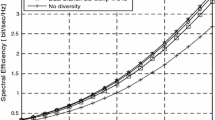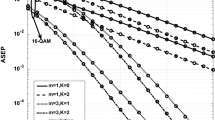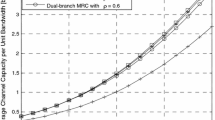Abstract
In this study, the performance of hexagonal quadrature amplitude modulation (HQAM) for a dual-branch selection combining (SC) receiver for beyond fifth-generation (B5G) is analyzed in detail. For general applicability, the links are modeled with η-μ fading channels. In this context, analytical expressions of error probability (EP) are derived in terms of the Chernoff, Chiani, Prony (2 and 3 terms), and Trapezoidal approximations for Gaussian Q-function. For the high signal to noise ratio (SNR) analysis, asymptotic EP expression is also derived by using the Chernoff approximation. Further, for the comparison, the analytical EP expressions with rectangular QAM and quadrature phase-shift keying modulation schemes are obtained by using the Chiani approximation. Moreover, a comprehensive work of various modulation schemes is presented and the effects of fading parameters, type of Gaussian Q-function approximations, and average SNR values of first and second links are highlighted on the EP performance. Finally, to show the accuracy of the proposed analytical derivations, some results for the exact simulations and numerical results are demonstrated.





Similar content being viewed by others
References
Andrews JG et al (June 2014) What will 5G be? IEEE Journal on Selected Areas in Communications 32(6):1065–1082
Rappaport TS et al (2013) Millimeter wave mobile communications for 5G cellular: it will work! IEEE Access 1:335–349
Akdeniz MR et al (June 2014) Millimeter wave channel modeling and cellular capacity evaluation. IEEE Journal on Selected Areas in Communications 32(6):1164–1179
Lu L, Li GY, Swindlehurst AL, Ashikhmin A, Zhang R (Oct. 2014) An overview of massive MIMO: Benefits and challenges. IEEE Journal of Selected Topics in Signal Processing 8(5):742–758
Bilim M, Kapucu N (2019) Average symbol error rate analysis of QAM schemes over millimeter wave fluctuating two-ray fading channels. IEEE Access 7:105746–105754
Gupta A, Jha RK (2015) A survey of 5G network: architecture and emerging technologies. IEEE Access 3:1206–1232
Swindlehurst AL, Ayanoglu E, Heydari P, Capolino F (September 2014) Millimeter-wave massive MIMO: the next wireless revolution? IEEE Commun Mag 52(9):56–62
Bilim M (2019) QAM signaling over κ–μ shadowed fading channels. Phys Commun 34:261–271
Dang S, Amin O, Shihada B, Alouini MS (2020) What should 6G be. Nature Electronics 3:20–29
Bilim M, Kapucu N (2019) On the analysis of achievable rate for NOMA networks with cooperative users over κ–μ shadowed fading channels. Int J Commun Syst 32(12)
Dai L, Wang B, Yuan Y, Han S, Wang Z (September 2015) Non-orthogonal multiple access for 5G: solutions, challenges, opportunities, and future research trends. IEEE Commun Mag 53(9):74–81
Ding Z, Yang Z, Fan P, Poor HV (Dec. 2014) On the performance of non-orthogonal multiple access in 5G systems with randomly deployed users. IEEE Signal Processing Letters 21(12):1501–1505
Ding Z et al (February 2017) Application of non-orthogonal multiple access in LTE and 5G networks. IEEE Commun Mag 55(2):185–191
Ding Z, Peng M, Poor HV (Aug. 2015) Cooperative non-orthogonal multiple access in 5G systems. IEEE Commun Lett 19(8):1462–1465
Sahana S, Mukherjee T, Sarddar D (2020) A conceptual framework towards implementing a cloud-based dynamic load balancer using a weighted round-robin algorithm. International Journal of Cloud Applications and Computing (IJCAC) 10(2):22–35
Wei Y, Li Q, Gong X, Guo D, Zhang Y (2019) Spectrum prediction and aggregation strategy in multi-user cooperative relay networks. International Journal of High Performance Computing and Networking 13(2). https://doi.org/10.1504/IJHPCN.2019.097500
D. Feng, Z. Wu, Z. Zhang and J. Fu, “On the conceptualization of elastic service evaluation in cloud computing,” Journal of Information Technology Research (JITR), vol 12 no.1, pp.1-13. 2019. (doi.10.4018/JITR.2019010103)
P. He, S. Luan, “Efficient algorithm for online data retrieval with one antenna in wireless networks” International Journal of High Performance Computing and Networking, vol 14, no.3, 2019. (https://doi.org/10.1504/IJHPCN.2019.102134)
Kapucu N, Bilim M, Develi I (2014) A closed-form MGF expression of instantaneous SNR for Weibull fading channels. Wirel Pers Commun 77(2):1605–1613
Forney GD Jr, Gallager RG, Lang GR, Longstaff FM, Qureshi SU (Sep. 1984) Efficient modulation for band-limited channels. IEEE J Sel Areas Commun 2(5):632–647
Tanahashi M, Ochiai H (Oct. 2009) A multilevel coded modulation approach for hexagonal signal constellation. IEEE Trans Wirel Commun 8(10):4993–4997
Han SH, Cioffi JM, Lee JH (Mar. 2008) On the use of hexagonal constellation for peak-to-average power ratio reduction of an OFDM signal. IEEE Trans Wirel Commun 7(3):781–786
Kapetanovic D, Cheng HV, Mow WH, Rusek F (May 2013) Optimal two-dimensional lattices for precoding of linear channels. IEEE Trans Wirel Commun 12(5):2104–2113
Srinath KP, Rajan BS (Feb. 2014) Fast-decodable MIDO codes with large coding gain. IEEE Trans Inf Theory 60(2):992–1007
Hekrdla M, Sykora J (Feb. 2014) Hexagonal constellations for adaptive physical-layer network coding 2-way relaying. IEEE Commun Lett 18(2):217–220
C. R. Doerr, L. Zhang, P. J. Winzer, and A. H. Gnauck, “28-Gbaud InP Square or Hexagonal 16-QAM Modulator,” in Proc. IEEE Conf. Opt. Fiber Commun. (OFC), Los Angeles, CA, USA, Mar. 2011, pp. 1–3.
M. Bilim, “Error Performance Evaluation of MIMO TAS/MRC with HQAM over Weibull Fading Channels (In Turkish),” in Congress of Electrical and Electronics Engineering, pp.410-413, 2019.
Singya PK, Kumar N, Bhatia V, Alouini M (2019) On performance of hexagonal, cross, and rectangular QAM for multi-relay systems. IEEE Access 7:60602–60616
N. Kumar, P. Singya, V. Bhatia (2020 On ASER performance of higher order QAM schemes in two-way multiple-relay networks under imperfect CSI. IET Communications.
Parvez S, Singya PK, Bhatia V (2020) On ASER analysis of energy efficient modulation schemes for a device-to-device MIMO relay network. IEEE Access 8:2499–2512
Parvez S, Singya PK, Bhatia V (2019) On impact of imperfect CSI over hexagonal QAM for TAS/MRC-MIMO cooperative relay network. IEEE Commun Lett 23(10):1721–1724
Shaik P, Singya PK, Bhatia V (2019) Performance analysis of QAM schemes for non-regenerative cooperative MIMO network with transmit antenna selection. AEU-International Journal of Electronics and Communications 107:298–306
D. Sadhwani, R. N. Yadav, S. Aggarwal and D. K. Raghuvanshi, "Simple and accurate sep approximation of hexagonal-QAM in AWGN channel and its application in parametric α−μ, η−μ, κ−μ fading, and log-normal shadowing," IET Commun, vol. 12, no. 12, pp. 1454-1459, 31 7 2018.
Sadhwani D (Oct. 2018) Simple and tightly approximated integrals over κ−μ shadowed fading channel with applications. IEEE Trans Veh Technol 67(10):10092–10096
Peppas K (Oct. 2013) Dual-hop relaying communications with cochannel interference over η − μ fading channels. IEEE Trans Veh Technol 62(8):4110–4116
Yang L, Hasna MO, Ansari IS (Dec. 2018) Physical layer security for TAS/MRC systems with and without co-channel interference over η-μ fading channels. IEEE Trans Veh Technol 67(12):12421–12426
Yang J, Chen L, Lei X et al (2016) Dual-hop cognitive amplify-and-forward relaying networks over η–μ fading channels. IEEE Trans Veh Technol 65(8):6290–6300
M. Bilim. “Uplink communications with AWGGN over non-homogeneous fading channels,” Phy. Commun., vol. 39, article no. 101047, 2020.
M. Bilim. “A performance study on diversity receivers over κ-μ shadowed fading channels,” AEU-International Journal of Electronics and Communications vol. 112, article no. 152934, 2019.
Peña-Martín JP, Romero-Jerez JM, Tellez-Labao C (2015) Performance of selection combining diversity in η − μ fading channels with integer values of μ. IEEE Trans Veh Technol 64:834–839
Yacoub MD (Feb. 2007) The κ-μ and the η-μ distribution. IEEE Antennas Propag Mag 49(1):68–81
Abramowitz M, Stegun IA (1972) Handbook of mathematical functions with formulas, graphs, and mathematical tables, 9th ed. Dover, New York, NY, USA
Gradshteyn, I.S., and Ryzhik, I.M.: ‘Table of integrals, series, and products’ (Academic Press, California, 2007, 7th edn.)
Rugini L (Aug. 2016) Symbol Error Probability of Hexagonal QAM. IEEE Commun Lett 20(8):1523–1526
Wozencraft JM, Jacobs IM (1965) Principles of communication engineering. Wiley, Hoboken, NJ, USA
Chiani M, Dardari D, Simon MK (July 2003) New exponential bounds and approximations for the computation of error probability in fading channels. IEEE Trans Wirel Commun 2(4):840–845
Loskot P, Beaulieu NC (March 2009) Prony and polynomial approximations for evaluation of the average probability of error over slow-fading channels. IEEE Trans Veh Technol 58(3):1269–1280
Sadhwani D, Yadav RN, Aggarwal S (Oct. 2017) Tighter bounds on the Gaussian Q function and its application in nakagami-m fading channel. IEEE Wireless Communications Letters 6(5):574–577
Prudnikov AP, Brychkov YA, Marichev OI (1986) Integrals, and series: special functions (Vol. 2). Gordon and Breach Sci, New York
Author information
Authors and Affiliations
Corresponding author
Additional information
Publisher’s note
Springer Nature remains neutral with regard to jurisdictional claims in published maps and institutional affiliations.
This article is part of the Topical Collection: Special Issue on P2P Computing for Beyond 5G Network and Internet-of-Everything
Guest Editors: Prakasam P, Ajayan John, Shohel Sayeed
Appendix
Appendix
According to (12), the I(a, b, c, d, x) integral is formatted as
With help of the finite series representation of γ(⋅, ⋅) is defined by \( \gamma \left(n,x\right)=\left(n-1\right)!\left[1-{e}^x\sum \limits_{m=0}^{n-1}\frac{x^m}{m!}\right] \) [43, eq. (8.352.6)], I(a, b, c, d, x) is rearranged as

By employing [43, eq. (3.381.4)], the integrals can be respectively written as
Finally, by combining L1 and L2, we obtain as
This concludes the proof.
Rights and permissions
About this article
Cite this article
Bilim, M. Dual-branch SC wireless systems with HQAM for beyond 5G over η-μ fading channels. Peer-to-Peer Netw. Appl. 14, 305–318 (2021). https://doi.org/10.1007/s12083-020-00946-x
Received:
Accepted:
Published:
Issue Date:
DOI: https://doi.org/10.1007/s12083-020-00946-x




